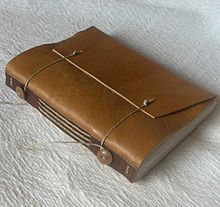Medieval Germany: it brought us Otto the Great, the formation of the Hanseatic League, and the first stirrings of the Protestant Reformation. It also, as best as we can discern, brought us long stitch bookbinding, a non-adhesive form of bookmaking (meaning it eschews the use of glue or other adhesives) that gained some popularity in 18th and 19th century Europe.
 The binding, which involves sewing signatures together through either holes or slits cut into the covers, was most commonly used on limp parchment bindings, meaning that it would have been popular for books used in keeping notes or records that could be left open without the pages turning. While its heyday may have come to an end some time ago, it’s still a popular binding method among DIY binders, and has been the decorative basis of a number of lovely volumes throughout the centuries.
The binding, which involves sewing signatures together through either holes or slits cut into the covers, was most commonly used on limp parchment bindings, meaning that it would have been popular for books used in keeping notes or records that could be left open without the pages turning. While its heyday may have come to an end some time ago, it’s still a popular binding method among DIY binders, and has been the decorative basis of a number of lovely volumes throughout the centuries.
For those of you who might have DIY tendencies, our first video is a tutorial on modern long stitch binding. Even for those of you who have no intention of making a book yourself, it’s still a useful way to understand (and see for yourself) the elements that go into long stitching, and some of the ways that it might differ from other forms of bookbinding.
While we’re fairly certain that the technique evolved in the 13th century, the elements that made this technique possible have a longer history. Even if we go back to the Romanesque period, we see the advances in sewing that make more modern bindings possible.
Today, the technique is primarily used in the context of books as art-objects. For many, this takes the form of notebooks (like the one in the video above) or Grimoires for personal use, but the technique also has a place in the world of fine press bookmaking—just another example of how history continues to inform the creation of beautiful books.









